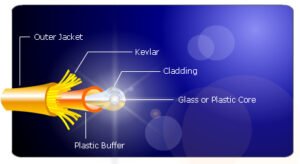 An efficient cabling system is one of the prerequisites for a functional network and is considered to be an investment that will comply with your networking needs in the long term. Fiber optic cabling is the product of modern technology. This type of cabling conveys information from one location to another through pulses of light in an optical fiber. It is important for users to learn the advantages of fiber optics.
An efficient cabling system is one of the prerequisites for a functional network and is considered to be an investment that will comply with your networking needs in the long term. Fiber optic cabling is the product of modern technology. This type of cabling conveys information from one location to another through pulses of light in an optical fiber. It is important for users to learn the advantages of fiber optics.
Fiber optic cables possess more bandwidth, or communications capacity, compared to metal and copper wires. This variety can transmit more information with greater reliability, which is one of the reasons for cable television and telephone providers to opt for fiber. The optical fiber also generates minimal power loss, thereby allowing longer transmission. Such cables are resistant against electromagnetic interference; they can operate in loud electrical environments because the interference does not have any effect on fiber cables.
Moreover, data moves at higher speeds since the fiber optic signal ensures that only a small amount of signal is lost in the course of transmission. Data is safe with fiber cables. It does not give off signals and is relatively hard to utilize. You will easily find out if the cable has been tapped or infringement has been made on the system, as this tampering causes the cable to give away light and causes the whole system to break down. Fiber optic cabling allows users to store electronics and hardware in a particular area rather than wiring cabinets with equipment.
Fiber optic cabling facilitates consistent transmission of data. The central part is fabricated from glass, an insulator, so that electricity cannot pass through. It is barely affected by ebb and flow of temperature, unlike copper, and can be immersed in water without any negative effects. Fiber optic is lightweight and thread like, but tougher than copper wiring. Specifications are a lot more than the copper cable. Although it is more difficult to terminate compared to copper, modern connectors make it easier to terminate.
The costs of fiber as well as other components are decreasing gradually but installation is more costly. Of course, fiber is more expensive than copper but it become more cost-effective in the long run due to less required maintenance, networking and downtime.
Practical users value their money. There may be certain downsides, such as installation expenses, but these are decreasing steadily each year. Fibers are also prone to damages because of the fine and smaller strands. Nevertheless, you can always institute safeguards that will address these points. Make it a point to determine the benefits of using fiber optic cabling. Install the highest quality of optic fiber cabling that your financial resources will allow.

